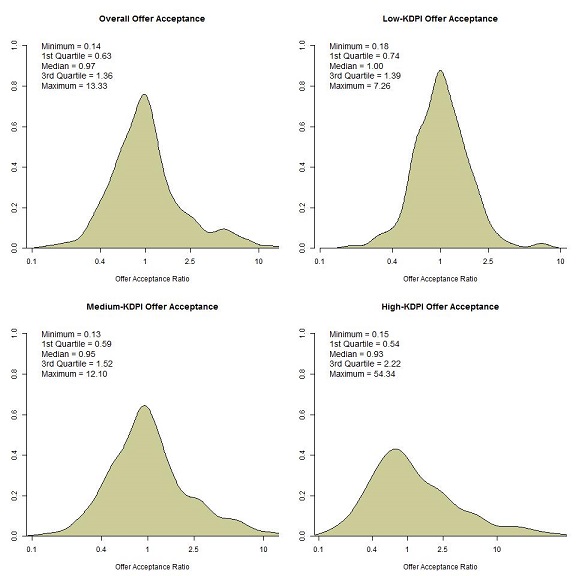Program-Specific Offer Acceptance Behavior for Kidney Programs Across the Spectrum of KDPI.
Scientific Registry of Transplant Recipients, Minneapolis, MN
Meeting: 2017 American Transplant Congress
Abstract number: A90
Keywords: Kidney transplantation, Public policy
Session Information
Session Name: Poster Session A: Deceased Donor Issues I: Allocation, KDPI and Recipient Selection
Session Type: Poster Session
Date: Saturday, April 29, 2017
Session Time: 5:30pm-7:30pm
 Presentation Time: 5:30pm-7:30pm
Presentation Time: 5:30pm-7:30pm
Location: Hall D1
Little is known about the offer acceptance behavior of kidney transplant programs, which affects rates of discard and access to transplant. An offer acceptance model was developed with offers to adult candidates from match runs that ended in acceptance between March 1, 2015, and August 31, 2015. The model adjusts for candidate and donor factors, including kidney donor profile index (KDPI), to estimate the expected acceptance probability for each offer. Generalized linear mixed models estimated program-specific offer acceptance ratios (OARs) for the overall candidate population and across strata of KDPI: low-KDPI (<35%), medium-KDPI (35-85%), and high-KDPI (>85%). Figure 1 and Table 1 illustrate the substantial variability in OARs that increases with KDPI. Program-specific OARs showed significant variability for even low-KDPI kidneys, ranging from 0.18 to 7.26 with more variability than the OARs for 1-year posttransplant graft survival of adult kidney recipients. Overall offer acceptance behavior was most strongly associated with acceptance of medium-KDPI kidneys followed by low- and high-KDPI kidneys. Offer acceptance behavior for high-KDPI kidneys was more strongly associated with offer acceptance of medium-KDPI kidneys than with offer acceptance of low-KDPI kidneys (Table 1). Due to substantial variability in program-specific offer acceptance practices, strategies should be considered to improve offer acceptance across the entire spectrum of donor KDPI, e.g., giving programs offer acceptance information across the spectrum of donor quality. Additionally, effective strategies for improving offer acceptance may vary across KDPI, especially for high- versus low-KDPI kidneys since there is only a mild association between the program-specific OARs for high- and low-KDPI kidneys.

CITATION INFORMATION: Wey A, Salkowski N, Kasiske B, Israni A, Snyder J. Program-Specific Offer Acceptance Behavior for Kidney Programs Across the Spectrum of KDPI. Am J Transplant. 2017;17 (suppl 3).
To cite this abstract in AMA style:
Wey A, Salkowski N, Kasiske B, Israni A, Snyder J. Program-Specific Offer Acceptance Behavior for Kidney Programs Across the Spectrum of KDPI. [abstract]. Am J Transplant. 2017; 17 (suppl 3). https://atcmeetingabstracts.com/abstract/program-specific-offer-acceptance-behavior-for-kidney-programs-across-the-spectrum-of-kdpi/. Accessed December 26, 2025.« Back to 2017 American Transplant Congress
